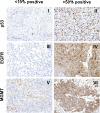Clinical variables serve as prognostic factors in a model for survival from glioblastoma multiforme: an observational study of a cohort of consecutive non-selected patients from a single institution
- PMID: 24004722
- PMCID: PMC3766209
- DOI: 10.1186/1471-2407-13-402
Clinical variables serve as prognostic factors in a model for survival from glioblastoma multiforme: an observational study of a cohort of consecutive non-selected patients from a single institution
Abstract
Background: Although implementation of temozolomide (TMZ) as a part of primary therapy for glioblastoma multiforme (GBM) has resulted in improved patient survival, the disease is still incurable. Previous studies have correlated various parameters to survival, although no single parameter has yet been identified. More studies and new approaches to identify the best and worst performing patients are therefore in great demand.
Methods: This study examined 225 consecutive, non-selected GBM patients with performance status (PS) 0-2 receiving postoperative radiotherapy with concomitant and adjuvant TMZ as primary therapy. At relapse, patients with PS 0-2 were mostly treated by reoperation and/or combination with bevacizumab/irinotecan (BEV/IRI), while a few received TMZ therapy if the recurrence-free period was >6 months.
Results: Median overall survival and time to progression were 14.3 and 8.0 months, respectively. Second-line therapy indicated that reoperation and/or BEV/IRI increased patient survival compared with untreated patients and that BEV/IRI was more effective than reoperation alone. Patient age, ECOG PS, and use of corticosteroid therapy were significantly correlated with patient survival and disease progression on univariate analysis, whereas p53, epidermal growth factor receptor, and O⁶-methylguanine-DNA methyltransferase expression (all detected by immunohistochemistry), tumor size or multifocality, and extent of primary operation were not. A model based on age, ECOG PS, and corticosteroids use was able to predict survival probability for an individual patient.
Conclusion: The survival of RT/TMZ-treated GBM patients can be predicted based on patient age, ECOG PS, and corticosteroid therapy status.
Figures


Similar articles
-
Immunohistochemical analysis of O6-methylguanine-DNA methyltransferase (MGMT) protein expression as prognostic marker in glioblastoma patients treated with radiation therapy with concomitant and adjuvant Temozolomide.J Egypt Natl Canc Inst. 2016 Mar;28(1):23-30. doi: 10.1016/j.jnci.2015.11.003. Epub 2015 Dec 10. J Egypt Natl Canc Inst. 2016. PMID: 26682634
-
Time trends in glioblastoma multiforme survival: the role of temozolomide.Neuro Oncol. 2013 Dec;15(12):1750-61. doi: 10.1093/neuonc/not122. Epub 2013 Sep 17. Neuro Oncol. 2013. PMID: 24046259 Free PMC article.
-
Hypofractionated-intensity modulated radiotherapy (hypo-IMRT) and temozolomide (TMZ) with or without bevacizumab (BEV) for newly diagnosed glioblastoma multiforme (GBM): a comparison of two prospective phase II trials.J Neurooncol. 2015 Jun;123(2):251-7. doi: 10.1007/s11060-015-1791-4. Epub 2015 Apr 29. J Neurooncol. 2015. PMID: 25920710 Clinical Trial.
-
Hypofractionated radiotherapy with or without concurrent temozolomide in elderly patients with glioblastoma multiforme: a review of ten-year single institutional experience.J Neurooncol. 2012 Apr;107(2):395-405. doi: 10.1007/s11060-011-0766-3. Epub 2011 Nov 22. J Neurooncol. 2012. PMID: 22105851 Review.
-
Association of tumor treating fields (TTFields) therapy with overall survival in newly diagnosed glioblastoma.Clin Transl Oncol. 2025 Jul;27(7):2904-2912. doi: 10.1007/s12094-025-03849-6. Epub 2025 Feb 1. Clin Transl Oncol. 2025. PMID: 39893330 Review.
Cited by
-
Prognostic significance of epidermal growth factor receptor expression in glioma patients.Onco Targets Ther. 2018 Feb 7;11:731-742. doi: 10.2147/OTT.S155160. eCollection 2018. Onco Targets Ther. 2018. PMID: 29445288 Free PMC article.
-
Mobile Clinical Decision Support System for Acid-base Balance Diagnosis and Treatment Recommendation.Acta Inform Med. 2017 Jun;25(2):121-125. doi: 10.5455/aim.2017.25.121-125. Acta Inform Med. 2017. PMID: 28883678 Free PMC article.
-
Use of the Response Assessment in Neuro-Oncology (RANO) criteria in clinical trials and clinical practice.CNS Oncol. 2019 Mar 1;8(1):CNS28. doi: 10.2217/cns-2018-0007. Epub 2019 Feb 26. CNS Oncol. 2019. PMID: 30806082 Free PMC article. Review. No abstract available.
-
A real-world observation of patients with glioblastoma treated with a personalized peptide vaccine.Nat Commun. 2024 Aug 11;15(1):6870. doi: 10.1038/s41467-024-51315-8. Nat Commun. 2024. PMID: 39127809 Free PMC article.
-
Dexamethasone administration during definitive radiation and temozolomide renders a poor prognosis in a retrospective analysis of newly diagnosed glioblastoma patients.Radiat Oncol. 2015 Oct 31;10:222. doi: 10.1186/s13014-015-0527-0. Radiat Oncol. 2015. PMID: 26520780 Free PMC article.
References
-
- Stupp R, Mason WP, van den Bent MJ, Weller M, Fisher B, Taphoorn MJ, Belanger K, Brandes AA, Marosi C, Bogdahn U, Curschmann J, Janzer RC, Ludwin SK, Gorlia T, Allgeier A, Lacombe D, Cairncross JG, Eisenhauer E, Mirimanoff RO. Radiotherapy plus concomitant and adjuvant temozolomide for glioblastoma. N Engl J Med. 2005;352:987–996. doi: 10.1056/NEJMoa043330. - DOI - PubMed
Publication types
MeSH terms
Substances
LinkOut - more resources
Full Text Sources
Other Literature Sources
Medical
Research Materials
Miscellaneous

